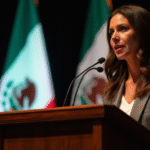Introduction
In today’s turbulent world, development financing might seem like a secondary agenda. However, it is now more urgent than ever. From June 30 to July 3, Seville will host the Fourth International Conference on Development Financing—a historic opportunity to reshape the global financial system towards a more equitable and resilient future.
The Latin American Context
For Latin America, this conference comes at a critical time. The region faces a development crisis marked by inequality, growing debt, weak institutions, limited access to financing, reduced fiscal space, and environmental vulnerability. According to CEPAL, the region is projected to only achieve 23% of the Agenda 2030 goals.
The Financing Gap
The draft guiding discussions in Seville warns that the annual financing gap for development exceeds four trillion dollars. To address this, Seville must mark the beginning of a profound transformation of the global financial system to close this gap.
Strengthening Public National Resources
A key pillar is to bolster national public resources. In low- and middle-income countries, tax revenues do not exceed 13% of the GDP. Tax evasion, avoidance, and illicit flows result in annual losses of up to 800 billion dollars. In Latin America, tax evasion amounts to 325 billion dollars, while the growth of the informal sector—an 18.6% increase over the past decade—reduces the tax base.
Facilitating Foreign Direct Investment and Recognizing Remittances
It’s crucial to facilitate foreign direct investment, modernize financial systems, and acknowledge the value of remittances, which tripled FDI in 2023. In Latin America, remittances reached 163 trillion dollars in 2023, surpassing 24% of the GDP in some nations. Reducing their transaction costs to less than 3% and integrating them into development strategies should be a global goal for 2030. Promoting financial inclusion and directing these resources towards productive investment is key for sustainable development.
Revitalizing International Cooperation
International cooperation needs revitalization. Official Development Assistance (ODA) remains below the agreed 0.7%, standing at only 0.37%. Latin America has been particularly affected by the “middle-income trap,” experiencing a 14% reduction in ODA flows in 2023. In light of these limitations, the Total Official Support for Sustainable Development (TOSSD) framework emerges as a more flexible and inclusive alternative to tackle these issues.
Expanding Multilateral Development Banks’ Lending Capacity
Multilateral Development Banks (MDBs) mobilize around 160 billion dollars annually, far below the required three to four trillion dollars. It’s urgent to expand their lending capacity and encourage South-South cooperation and innovative financing mechanisms.
Central Role of Climate Finance
Insufficient resources for adaptation and mitigation will keep vulnerable countries bearing the costs of a crisis they did not cause.
Rethinking International Trade
Currently, the least developed countries represent only 1% of global exports. Reforming the WTO, promoting fair agreements, and simplifying regulations are essential for effective integration.
Debt and its Impact
Thirty countries are over-indebted or at high risk. In Latin America, external debt reached an average of 55% of the GDP in 2023. This reflects a slow, ineffective, and unjust debt architecture.
Reforming the International Financial Architecture
Developed countries control 60% of the IMF quotas. Moreover, the gender gap persists, with less than 30% women in senior positions in multilateral financial institutions. This lack of representation directly impacts Latin America, which has limited influence in decisions made by multilateral organizations.
Conclusion: The Path Forward
Key Questions and Answers
- Q: What is the main focus of the Seville Conference? A: The conference aims to reshape the global financial system for a more equitable and resilient future, addressing critical development financing challenges.
- Q: Why is development financing crucial for Latin America? A: Latin America faces a development crisis marked by inequality, growing debt, weak institutions, limited access to financing, reduced fiscal space, and environmental vulnerability.
- Q: How can public national resources be strengthened? A: By tackling tax evasion, avoidance, and illicit flows, and integrating the informal sector while reinforcing public development banks.
- Q: What role do remittances play in Latin American development? A: Remittances have tripled FDI in 2023, reaching 163 trillion dollars in Latin America. Reducing their transaction costs and integrating them into development strategies is vital.
- Q: How can international cooperation be revitalized? A: By encouraging the Total Official Support for Sustainable Development (TOSSD) framework and expanding multilateral development banks’ lending capacity.
- Q: Why is climate finance essential? A: Insufficient resources for adaptation and mitigation will keep vulnerable countries bearing the costs of a climate crisis they did not cause.
- Q: How can international trade be rethought? A: By reforming the WTO, promoting fair agreements, and simplifying regulations for effective integration.
- Q: What are the implications of high debt levels in Latin America? A: Thirty countries are over-indebted or at high risk, with external debt averaging 55% of the GDP in Latin America. This reflects a slow, ineffective, and unjust debt architecture.
- Q: Why is reforming the international financial architecture necessary? A: Developed countries control 60% of the IMF quotas, and the gender gap persists in multilateral financial institutions, limiting Latin America’s influence in decision-making.






